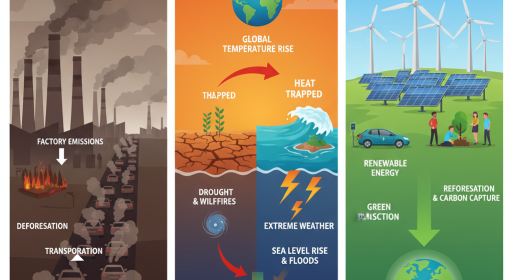This report aims to provide insights into the implications of climate change for Nigeria’s precipitation and temperature extremes. By highlighting the expected trends and their potential impacts, it serves as a valuable resource for policymakers, researchers, and stakeholders focused on climate resilience and sustainable development planning. Understanding these future trends is essential for formulating informed strategies to build climate resilience and promote sustainable practices in Nigeria. Further research will be critical in refining these projections and exploring localized impacts at finer scales.

The examination of precipitation and temperature extremes in Nigeria is vital for several reasons. Firstly, Nigeria is experiencing noticeable effects of climate change, similar to many other nations. By comprehending how these extremes will shift, we can evaluate their impact on ecosystems, agriculture, water resources, and socio-economic development across the country.
Secondly, Nigeria’s reliance on rain-fed agriculture makes it particularly susceptible to climate change, with limited capacity for adaptation. Analyzing projections for precipitation and temperature can help identify regions most at risk and inform the development of tailored adaptation strategies that mitigate negative impacts and enhance resilience. Furthermore, accurate predictions of precipitation patterns are essential for effective water resource management. Changes in extreme weather can affect water availability, increase drought frequency, and heighten flood risks. Understanding these patterns enables the formulation of sustainable water management strategies, including reservoir operations, irrigation planning, and flood protection measures.

Additionally, extreme temperature events pose significant risks to public health and safety. Understanding projected temperature changes allows for the implementation of strategies to mitigate adverse effects, such as establishing heatwave early warning systems, improving urban planning to combat the urban heat island effect, and enhancing healthcare infrastructure.
Lastly, projections of precipitation and temperature extremes provide critical information for policymakers and decision-makers. This knowledge supports the development of climate change policies, resource allocation, disaster risk reduction strategies, and long-term planning. Equipped with this information, stakeholders can make informed decisions that minimize climate-related risks while maximizing opportunities for sustainable development.
In conclusion, the study of precipitation and temperature extremes in Nigeria is essential for understanding climate change impacts, assessing vulnerability and adaptation, managing water resources, addressing public health concerns, and informing policy and decision-making processes. These insights are invaluable for promoting Nigeria’s sustainable development and resilience across socio-economic and ecological systems.

Recommendations
- Irrigation Farming: Implementing irrigation systems during dry seasons can help sustain crops, particularly in anticipation of drought conditions. Greenhouses can also utilize irrigation year-round.
- Improve Drainage Infrastructure: Investing in enhanced drainage systems, such as canals and stormwater pipes, can effectively redirect excess water and prevent flooding in vulnerable areas.
- Implement Flood Control Measures: Constructing levees, dams, and other flood control structures can mitigate the effects of heavy rainfall and flooding.
- Promote Water Conservation: Encouraging water-saving practices, such as rainwater harvesting and using low-flow fixtures, can help minimize drought risk.
- Implement Soil Conservation Techniques: Adopting methods like conservation tillage and cover cropping can enhance soil health, improving water retention and reducing erosion.
- Careful Land Use Planning: Strategic land use planning can mitigate damage from precipitation extremes by avoiding development in flood-prone areas and ensuring structures are resilient to extreme weather.
- Invest in Early Warning Systems: Establishing effective weather monitoring and alert systems can provide advance notice of extreme weather events, allowing communities to prepare and respond accordingly.
- Reduce Energy Use: Implementing energy-efficient practices can help minimize the adverse effects of temperature extremes and lower energy costs. Simple actions, such as turning off unnecessary lights and using energy-efficient appliances, can make a difference.
- Plant Trees or Install Shade Structures: Establishing trees or shade structures can mitigate heat effects, particularly in urban environments.
These strategies are just a few ways to address the adverse effects of precipitation and temperature extremes. It is crucial to take proactive measures and prepare for extreme weather conditions to ensure safety and well-being.
Take Action Now
Schedule a Free Consultation!
We are dedicated to creating a positive impact on the environment, society, businesses, and sectors. By choosing us, you are not just investing in your business but also contributing to a more sustainable and resilient future for all.




